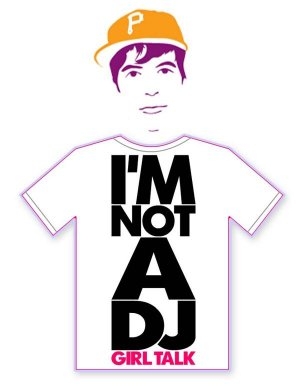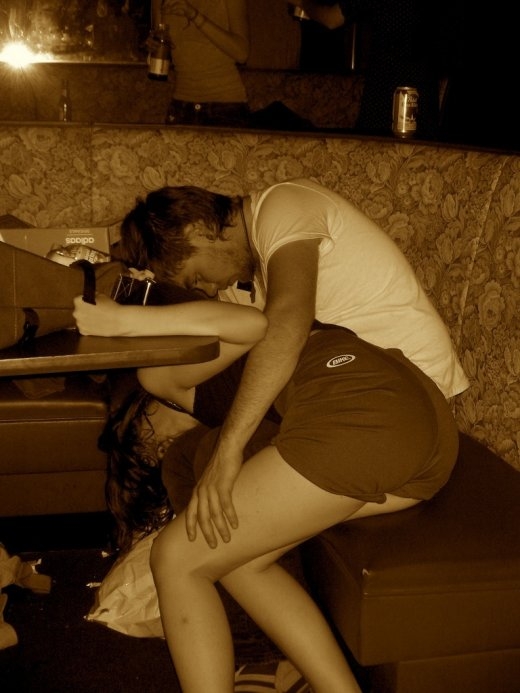
[Photo by ANDREW STRASSER]
![]() BY DAVE ALLEN Talk about getting your peanut butter in my chocolate: Lil Mama rhyming about her lipgloss mashed-up with the hammering of Metallica‘s “One.” Youngbloodz declaring that he don’t give a fuck to the smooth organ strains of Procol Harum. The dance music of Girl Talk, AKA Gregg Gillis, is so loaded with these types of bizarre combinations that you could almost measure it in terms of WTFs instead of BPMs, but Gillis’ skills in keeping the grooves seamless behind the constantly-changing samples makes his latest, Feed the Animals, an ear-worming winner (now playing on Phawker Radio!). We ask him about his roots in electronic music, the legality of sampling en masse, and his home at the other end of our fine state.
BY DAVE ALLEN Talk about getting your peanut butter in my chocolate: Lil Mama rhyming about her lipgloss mashed-up with the hammering of Metallica‘s “One.” Youngbloodz declaring that he don’t give a fuck to the smooth organ strains of Procol Harum. The dance music of Girl Talk, AKA Gregg Gillis, is so loaded with these types of bizarre combinations that you could almost measure it in terms of WTFs instead of BPMs, but Gillis’ skills in keeping the grooves seamless behind the constantly-changing samples makes his latest, Feed the Animals, an ear-worming winner (now playing on Phawker Radio!). We ask him about his roots in electronic music, the legality of sampling en masse, and his home at the other end of our fine state.
PHAWKER: Tell me about how you arrived at making music the way you do. Did you used to play in bands, etc. Do you play any instruments. What was the ‘aha moment’ that lead to you becoming Girl Talk.
GIRL TALK: I don’t play any traditional instruments. I started an experimental electronic band with some  friends when I was 15. We were called The Joysticks Battle The Scan Feed Relay To Your Skull. I played keyboards, synthesizers, circuit bent toys, broken electronics, 4-track recorders, skipping CD’s, boomboxes, and other things like that. During the last year of that band, my senior year of high school, we got heavily into working with samples and damaging Top 40 music. That band had to break up when we graduated because we were all moving away from each other. I got a laptop right before I moved to Cleveland for college, so I decided to start the Girl Talk project, which was planned to be entirely about processing, re-contextualizing, and collaging pop music.
friends when I was 15. We were called The Joysticks Battle The Scan Feed Relay To Your Skull. I played keyboards, synthesizers, circuit bent toys, broken electronics, 4-track recorders, skipping CD’s, boomboxes, and other things like that. During the last year of that band, my senior year of high school, we got heavily into working with samples and damaging Top 40 music. That band had to break up when we graduated because we were all moving away from each other. I got a laptop right before I moved to Cleveland for college, so I decided to start the Girl Talk project, which was planned to be entirely about processing, re-contextualizing, and collaging pop music.
PHAWKER: Explain Fair Use for dummies and why you think it protects your use of samples, and about some the hoops you’ve had to jump through with regard to copyrights and famous artists.
GIRL TALK: I’ve jumped through zero hoops. Fair Use is a doctrine in United States copyright law that allows you to sample pre-existing works without asking for permission if your new work follows a certain criteria. It’s a subjective look into the nature of what you are doing. It looks at your intentions, how you’re impacting the potential sales of the source material, how transformative the new work is, and other things on that level. I believe that my work is transformative. It obviously has recognizable elements of pre-existing songs, but based on the re-contextualizations, I think it becomes a new entity. It is not negatively impacting the sales of any of the source material. If anything, it’s turning new people onto this music.
PHAWKER: What do you say to critics or other varieties of haters who say that what you are doing is not creating but rather re-creating? What do you feel unites Feed the Animals, for example, as an album rather than a DJ mix?
GIRL TALK: You can’t make music without influence. Everything is based on something from the past. Every new piece of music is about recycling ideas, manipulating them, and placing it in a new context. I view the computer or sampler as an instrument. I’m playing it, just like a guitarist plays his/her instrument based on rhythmic patterns, tunings, chord progressions, or tones that have already been established in previous works. Every musician works with appropriated templates. You can be very original with how you manipulate that template on a guitar or on a computer or on any instrument. This dates back to the origins of music itself. With Feed the Animals, there’s no point where it’s an unmanipulated version of source material just playing. At every moment on the album, there are various elements collaged together, pitched adjusted, and signal processed. I’m not trying to present songs that people know; I’m trying to make new music out of elements from songs that people know.
 PHAWKER: In your live performances, how faithful are you to the tracks on Feed the Animals and Night Ripper? Are you recreating it live or basically pressing ‘PLAY’?
PHAWKER: In your live performances, how faithful are you to the tracks on Feed the Animals and Night Ripper? Are you recreating it live or basically pressing ‘PLAY’?
GIRL TALK: The live show is constantly evolving. I’m always re-working elements of it. Most of the the material I play live these days is reinterpretations of things from the past mixed in with new material. I like to do new remixes of familiar elements from my albums. At some points, I try to play parts as close to the album material as possible, but that’s not too common.
I use a program called Audiomulch to perform. I use it in a particular way where I’m controlling a bunch of loops. Everything is as isolated as possible. So when you hear just a drum beat, that could be four loops right there: kick drum loop, hi hat loop, snare drum loop, and hand clap loop. I trigger these loops in real time. If I want to take the hand clap out from the beat, I can. Even with the melodies, everything is very isolated. So if you hear the music go from the “Tiny Dancer” piano to “Tiny Dancer” piano with bass to “Tiny Dancer” chorus, those are three separate loops. When those parts transition, it’s me muting one loop and triggering another. Nothing is automated. It’s easy to notice that when I step away from the computer, the same material will constantly loop until I get back to switch it up. At the end of Lollapalooza this year, I jumped in the crowd while with a loop from Journey “Faithfully” playing. I crowd surfed back to the sound board. That took me about eight minutes, and if you check the YouTubes, you can hear that part on loop for the entire duration. It’s basically as live as sound collage can be.
PHAWKER: I know it’s a good city for sports, bars, and music, but after launching your career, why stay in Pittsburgh?
GIRL TALK: It’s the best city in the world with the best people.
PHAWKER: I’m told I can expect the removal of clothing and lots of people dancing on stage at your concerts. What’s the craziest thing anyone’s done on stage with you?
GIRL TALK: People have had sex on stage.

SLEEPYHEADS: Couple takes a break from the dance floor with a well-earned nap, Girl Talk, Starlight Ballroom, Sept. 17th, 2007 [Photo by EVA LIAO]
